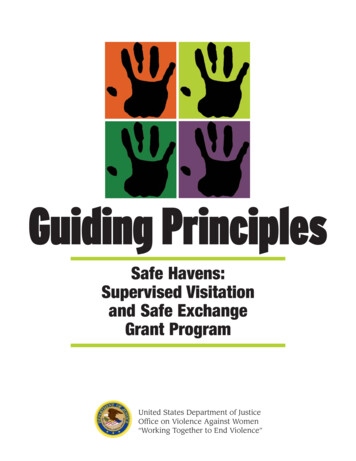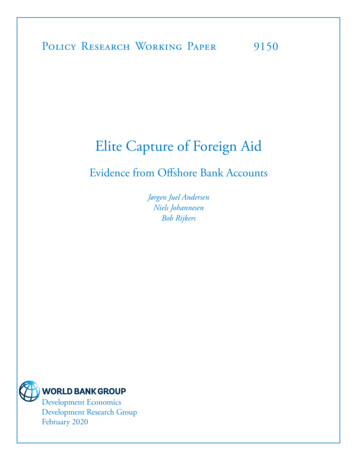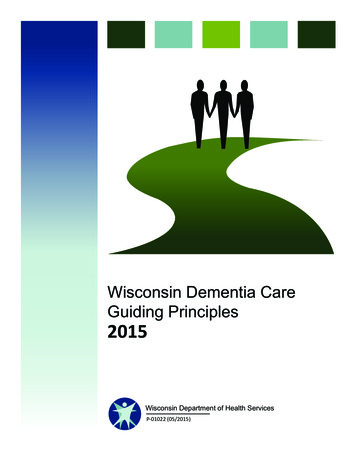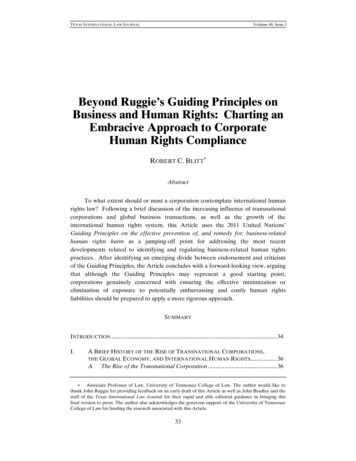
Transcription
Guiding PrinciplesSafe Havens:Supervised Visitationand Safe ExchangeGrant ProgramUnited States Department of JusticeOffice on Violence Against Women“Working Together to End Violence”
AcknowledgementsIt is because of the tireless efforts,commitment, dedication, and vision of National SteeringCommittee members, Supervised Visitation Program grantees,technical assistance providers, staff of the Office on ViolenceAgainst Women, and consultants that the Guiding Principlescame to fruition. Included in this document is a completelisting of each person who contributed to the developmentof the Guiding Principles(Appendix C).United States Department of JusticeOffice on Violence Against Women800 K Street, NW, Suite 920Washington, DC 20530Michael B. MukaseyAttorney GeneralUnited States Department of JusticeMary Beth BuchananActing DirectorOffice on Violence Against Womenhttp://www.ojp.usdoj.gov/ovwDecember, 2007This project was supported by Grant No. 2006-WT-AX-K026 awarded by theUnited States Department of Justice, Office on Violence Against Women.2
Table of ContentsSection One: Supervised Visitation in Cases of Domestic ViolenceIntroduction.5Separation and Custody in the Context of Domestic Violence. .6Defining the Role of Grantees and Visitation Centers. .6 Role of the Grantee Role of the Visitation CenterThe Guiding Principles.8 What Are They?How Were They Developed?Principles, Standards, and PracticesHow To Use This DocumentSection Two: The Guiding PrinciplesPrinciple I: Equal Regard for the Safety of Child(ren) and Adult Victims. .13Principle II: Valuing Multiculturalism and Diversity.19Principle III: Incorporating an Understanding of Domestic Violence.23into Center ServicesPrinciple IV: Respectful and Fair Interaction. .29Principle V: Community Collaboration.33Principle VI: Advocacy for Child(ren) and Adult Victims. .37Section Three: AppendicesAppendix A: Glossary of Terms.43Appendix B: Grant Program. .45Appendix C: Contributors. .473
4
IntroductionSupervised visitation and exchange services provide parents who may present a risk to theirchildren or to another parent the opportunity to have parent-child contact monitored by anappropriate third party.1 Long recognized as a service crucial for families whose childrenhave been removed from the home because of child abuse or neglect allegations, visitationcenters have begun to emerge as a service for some families engaged in child custody dis putes, and for families with histories of domestic violence and other allegations of parentalmisconduct.2Advocates have long called for the use of supervised visitation services in domestic violencecases to reduce the risks to child(ren) and adult victims3 and to mitigate the effects of suchviolence on all members of the family.4 Although safer than unsupervised contact, traditionalchild welfare-based supervision has vastly different goals, security issues, and staffing issuesthan those necessitated by domestic violence cases.5The United States Congress acknowledged the need for available and appropriatesupervised visitation and exchange services for child(ren) and adult victims of domesticviolence and established the Safe Havens: Supervised Visitation and Safe ExchangeGrant Program6 (Supervised Visitation Program) as part of the Violence Against Women Actof 2000. This program is designed to increase supervised visitation and exchange services forvictims of domestic violence, sexual assault, stalking, dating violence, and child abuse.7 TheSupervised Visitation Program seeks to shift the focus of supervised visitation and exchangein domestic violence cases in an important way: where the traditional purpose of supervisedvisitation was to keep the children safe while allowing continued access by the parents,8Supervised Visitation Program grantees, funded by the United States Department of Justice,Office on Violence Against Women (OVW),9 must consider as their highest priority the safetyof both children and adult victims.1Robert B. Straus & Eve Alda, Supervised Child Access: The Evolution of a Social Service, 32 FAM. & CONCIL. CTS. REV. 230, 231 (1997).Nancy Thoennes & Jessica Pearson, Supervised Visitation: A Profile of Providers, 37 FAM. & CONCIL. CTS. REV. 460 (1999).3While it is recognized that not all victims of domestic violence are women, a multitude of research supports that the overwhelmingmajority, in some studies as high as 95%, of domestic violence victims are women. See, e.g., Bureau Just. Stat., United StatesDepartment of Justice, Family Violence Statistics: Including Statistics on Strangers and Acquaintances 1 (2005) athttp://www.ojp.usdoj.gov/bjs/pub/pdf/fvs.pdf (last visited Aug. 25, 2005).4M. Sharon Maxwell & Karen Oehme, Violence Against Women Online Resources, Strategies to Improve Supervised Visitation Servicesin Domestic Violence Cases 2, at strategies/strategies.pdf (last visitedSept. 11, 2006).5Id. at 3.642 U.S.C. § 10420 (2006) (creating Safe Havens for Children).7Supervised Visitation Program grantees are funded to serve victims of domestic violence, sexual assault, stalking, dating violence,and child abuse; the phrase “child(ren) and adult victims of domestic violence” is used throughout the document because theprimary focus of the Supervised Visitation Program is serving domestic violence victims.8See, e.g., Kathryn Marsh, The Service, in NEW YORK SOCIETY FOR THE PREVENTION OF CRUELTY TO CHILDREN PROFESSIONALS’ HANDBOOK ONPROVIDING SUPERVISED VISITATION, 34 (Anne Reiniger ed., 2000).9See 42 U.S.C.A. § 10420 (2006) for the specific provision regarding the Supervised Visitation Program.25
Separation and Custody in the Context of Domestic ViolenceSeparation often signifies an end to a relationship; but for many adult victims of domesticviolence, separation marks instead an escalation of the batterer’s violence and manipulativetactics. Emotional, psychological, sexual, financial and physical abuse, stalking, and harass ment often continue at significant rates post-separation and may become even more severe.10Awards of custody and visitation to the batterer ensure continued contact between the adultvictim and the batterer, thereby creating an opportunity for the batterer to continue the abuse.Lethal violence occurs more frequently during and after separation than when the adultvictim and batterer are still together,11 and the children can be targets of or witnesses to thisviolence. It is difficult, however, to predict in exactly which case, or under what circum stances, the adult victim and the children are at risk.12Even as courts continue to struggle to balance the competing considerations for safety fromfurther domestic violence on the one hand and parental access on the other, they usuallyorder some level of parent-child contact to the battering parent. Such orders often requireadult victims to ensure that the parent-child contact takes place, in many cases resulting incompromised safety for themselves and the children during the exchange. Alternatively,courts may place custody of the children with the batterer and order the adult victim to visitthe children in a supervised setting. Regardless of the situation, the Supervised VisitationProgram seeks to provide services to families in ways that meet their individual safety needs.Defining the Role of Grantees and Visitation CentersGearing supervised visitation and exchange services to achieve the program goals requirescareful elucidation of the roles of the respective professionals and systemsoperating within the Supervised Visitation Program and solid collaboration amongthose involved.Role of the GranteePer statutory requirement,13 the Supervised Visitation Program mandates that a unit ofgovernment apply for and maintain the grant and that grantee communities establishcommunity working groups, which at a minimum must have representation from thedomestic violence or sexual assault advocacy community, the court, the supervised10See PETER G. JAFFE, NANCY K.D. LEMON & SAMANTHA E. POISSON, CHILD CUSTODY & DOMESTIC VIOLENCE: A CALL FOR SAFETY ANDACCOUNTABILITY (2003).11See Jacquelyn C. Campbell et al., Risk Factors for Femicide in Abusive Relationships: Results from a Multistate Case Control Study, 93AM. J. PUB. HEALTH 1089-97 (2003); and Walter S. DeKeseredy, McKenzie Rogness & Martin D. Schwartz, Separation/Divorce SexualAssault: The Current State of Social Scientific Knowledge, 9 AGGRESSION & VIOLENT BEHAV. 675 (2004), available ualassault.pdf (last visited Sept. 12, 2006).12Because it is difficult to determine lethality, adult victims play an essential role in safety planning as they often are more acutelyaware of the intentions and potential risks of their batterer. For more discussion, see Principle I, Equal Regard for the Safety ofChild(ren) and Adult Victims, infra.13U.S.C.A., supra note 9.6
visitation and exchange program, and the unit of government. These partnerships allow granteecommunities to: Build capacity for coordinated community responses; View the problems or challenges through diverse lenses; Address existing systems and improving responses; and Create a partnership and coordination among community entities in order to ensurecontinuity of services.Role of the Visitation CenterThe visitation center is part of a larger community response to enhance the safety of child(ren)and adult victims and hold batterers accountable, while providing access to visitation andexchange services. Visitation centers are among few programs that interact with each memberof the family. As such, they have a unique opportunity to identify needs and gaps in services forchild(ren) and adult victims, batterers, and the community at large. Visitation centers servingchild(ren) and adult victims of domestic violence are in a position to: Provide a safe space for children to visit with the non-custodial parent; Help keep child(ren) and adult victims of domestic violence safe during exchangesand visitation; Hold batterers accountable for their violence and abuse during visitation andexchange; Be part of an expansion of services to support child(ren) and adult victims; and Provide access to meaningful referrals.7
The Guiding PrinciplesWhat Are They?The Guiding Principles of the Safe Havens: Supervised Visitation and Safe Exchange GrantProgram (Guiding Principles) are designed to guide the development and administration ofSupervised Visitation Program centers with an eye toward addressing the needs of child(ren)and adult victims of domestic violence in visitation and exchange settings. The GuidingPrinciples look beyond the visitation setting to address how communities funded under theSupervised Visitation Program should address domestic violence in the larger community.In addition, the Guiding Principles: Provide guidance for communities developing or enhancing supervised visitationand exchange services for families experiencing domestic violence, child abuse,sexual assault, dating violence, or stalking; Serve as a reference for drafting policies and protocols for these services; and Assist collaborations with shaping, informing, and reviewing local supervisedvisitation and exchange services to address domestic violence.How Were They Developed?The Supervised Visitation Program National Steering Committee (Committee) developed theseprinciples, standards, and practices during a three-year period beginning in November 2003.During the three years, the Committee met six times and engaged in concentrated discussionsaround the myriad issues associated not only with supervised visitation and exchange, butalso with the personal and systemic obstacles facing child(ren) and adult victims of domesticviolence. These discussions required representation from various disciplines of practice,which included members from the judiciary and legal community, child welfare and domesticviolence services, supervised visitation and exchange services, batterer intervention services,culturally-specific organizations, mental health professionals, federal agencies, and the aca demic community. Just as the grantee communities bring various players to the table, sodid the Committee, setting the stage for a document informed by the opinions,experiences, and lenses of this diverse group.Because of the desire to draft a document that speaks to the philosophy of the SupervisedVisitation Program and is usable by grantee communities on a practical level, representativesfrom Supervised Visitation Program grantee communities were brought into the process start ing in 2004. A year later, a smaller group of grantees attended a Committee meeting andhelped develop the standards and practices associated with each principle.Principles, Standards, and PracticesThe Guiding Principles document is broken down into three categories—principles,standards, and practices.In total there are six guiding principles:Principle I: Equal Regard for the Safety of Child(ren) and Adult VictimsPrinciple II: Valuing Multiculturalism and DiversityPrinciple III: Incorporating an Understanding of Domestic Violence into Center Services8
Principle IV: Respectful and Fair InteractionPrinciple V: Community CollaborationPrinciple VI: Advocacy for Child(ren) and Adult VictimsThe Guiding Principles embody the statutory requirements and objectives of the SupervisedVisitation Program. Each guiding principle (overarching philosophy andperspective) is accompanied by standards (expectations based on the guiding principle) andpractices (concrete activities based on the principle and standard). The goal ofdeveloping the Guiding Principles is to help guide best practice in the provision of safe visita tion and exchange services and in the overall community response to child(ren) and adult vic tims of domestic violence.How to Use This DocumentThis document is designed for use by all community partners and has been crafted usinglanguage that will speak to varying disciplines. Because definitions are not often universal,a glossary of terms is included at the back of the document (Appendix A). The principlesoutlined in this document were identified by the Committee and are intended to guidepractice around supervised visitation and exchange for communities funded under theSupervised Visitation Program. As stated above, the Guiding Principles represent overarchingphilosophies that communities can use as a framework for center operation. Each principleincludes: A narrative section, which provides context for each principle; Standards, which are general expectations that should be met by SupervisedVisitation Program centers; and Practices, which are concrete ways to accomplish the expectations outlined in thestandards.While the standards and practices included in this document are considered to be good prac tice when addressing the needs of victims of domestic violence, centers funded under theSupervised Visitation Program can and are encouraged to go beyond the practices outlinedwithin this document.9
10
THEGUIDINGPRINCIPLES11
12
Principle IEqual Regardfor the Safety ofChild(ren) andAdult VictimsVisitation centers should consider as theirhighest priority the safety of child(ren) and adultvictims and should treat both with equal regard.Visitation centers play a critical role in fostering the safety of child(ren) and adult victimsduring a time of increased danger when the parents separate.14 As more visitation centersincreasingly work with families experiencing domestic violence and respond to the needs ofchild(ren) and adult victims, it becomes critically important that center services build safetyinto their practices, management structure, and work within their community collaborative.If safety concerns are not adequately addressed, supervised visitation and exchange canincrease a batterer’s opportunity to commit continued, and sometimes lethal, violence againstchild(ren) and adult victims; to follow through with threats to abduct the children; or tofurther the abuse by stalking, harassing, refusing to cooperate in the exchange or visit, orattempting to coerce adult victims into returning to the relationship.15Because of these risks, visitation centers have become an essential service for cases involvingdomestic violence.16 It is important, therefore, for visitation centers to understand that thesafety needs of child(ren) and adult victims are often linked. Research shows that the well being of children exposed to domestic violence can generally be restored if adult victimsreceive support to create safety and stability in their own lives,17 which in turn can provide asafer and more secure environment for the children.Visitation centers are not expected to eliminate all of the dangers or risks present in domesticviolence situations. However, with careful planning, centers can take steps that will enhancethe safety of child(ren) and adult victims to the greatest extent possible.14DeKeseredy et al., supra note 11, at 675.Maureen Sheeran & Scott Hampton, Supervised Visitation in Cases of Domestic Violence, 50 JUV. & FAM. CT. J. 13, 14 (1999); see alsoPeter Jaffe, Claire Crooks & Samantha Poisson, Common Misconceptions in Addressing Domestic Violence in Child Custody Disputes, 54JUV. & FAM. CT. J. 57, 60 (Fall 2003) (discussing one study where 25% of the women reported that their lives were threatened duringaccess).16Sheeran & Hampton, id.17SUSAN SCHECHTER & JEFFREY L. EDLESON, OPEN SOC’Y INST., DOMESTIC VIOLENCE & CHILDREN: CREATING A PUBLIC RESPONSE 5-6, 11 (2000) (stat ing that women’s psychological well-being and mental health is strongly associated with obtaining multiple forms of social supportincluding financial aid, social services, legal assistance, and informal social networks).1513
Standards and PracticesUse various methods to ensure the physical, auditory, and visual separationof parents while on-site and to decrease the likelihood that parents will comeinto contact with one another while traveling to and from the center. Offer staggered arrival and departure times.Develop a policy requiring visiting and custodial parents to arrive and depart at staggeredintervals. Because safety and other needs change over time, the arrival and departure sched ule of each family should be designed (and redesigned when necessary) to meet the uniquesafety needs and concerns of the child(ren) and adult victims. In some cases, the visitingparent may be the victim and the custodial parent may be the batterer. Therefore, designingarrival and departure times based solely on custodial status is discouraged. Examine facility design.Select a facility where the design will decrease the opportunity for parents to come intocontact with one another and will include such features as separate entrances, separate park ing lots, and separate waiting rooms. In circumstances where such features are not availableor cannot be accommodated, develop enhanced procedures to ensure the parents do notcome in contact with one another. Allow custodial parents to wait on- or off-site.Allow custodial parents to wait on- or off-site, based on the safety needs, age, and develop mental stage of the visiting children, needs of visiting children with disabilities, and otherconcerns of child(ren) and adult victims. Make the waiting area secure and in a location notaccessible to the other parent.Develop and implement security18 measures and protocols that meet thediverse safety needs of the community and individuals using visitation centerservices. Develop security protocols.Develop security policies and protocols that meet the safety needs of the community andindividuals using visitation center services, seeking input from the community collaborative.Policies and protocols can address such issues as the use of security personnel and securitydevices.18Security refers to the physical measures utilized to support the safety of staff and individuals using program services while on-site.Such security measures can include uniformed or plain-clothed officers, video monitoring equipment, metal detectors, panicbuttons, etc.14
Inform referral agencies.Inform courts and other referring agencies of the security measures in place, along with thephilosophy behind such measures, so that such agencies can make informeddecisions about where to refer cases. Inform child(ren) and adult victims.Inform child(ren) and adult victims of the security measures and safety features in place,along with options for additional safety measures that could be put in place, so that child(ren)and adult victims can build into their safety plan those measures that will enhance theirunique safety needs. Work with law enforcement.Encourage, and work with, local law enforcement to develop a protocol for responding tocalls from the center, and seek assistance from law enforcement in developing other securityprotocols.Acknowledge and exercise the discretion visitation centers have in rejectingcases or suspending or terminating services or individual visits/exchanges ininstances where such services cannot provide for the safety needs ofchild(ren) and adult victims. Centers should develop criteria by which suchdecisions are made, based on safety considerations. Reject cases.Communicate to individuals using services and referring agencies the criteria for rejecting acase; reject cases if the emotional or physical safety of child(ren) and adult victims, centerstaff, or other individuals using services cannot be ensured. End visits.End visits, or do not allow exchanges to take place, if parents engage in behavior that com promises or endangers the emotional or physical safety of child(ren) or adult victims, centerstaff, or other individuals using services. Prior to terminating a visit and if it is safe to do so,center staff can attempt to redirect or stop a parent’s behavior. Terminate services.Develop criteria by which services to a family will be terminated based on the safety risks tochild(ren) and adult victims, center staff, and other individuals using services; terminate acase accordingly. Inform referral source.Develop a protocol to inform the referring agency that a case was rejected or terminated andthe underlying reasons for such action.15
Develop community response.Develop a protocol within the community collaborative to address cases that are toodangerous for supervised visitation services and that have been rejected or terminated; deter mine whether the protocol should address referring the battering parent to other servicessuch as a batterer intervention program.Develop policies and procedures addressing the way information is gathered,maintained, and released that promote the safety of child(ren) and adultvictims; seek the guidance of community partners, including legalprofessionals, as needed. Develop an information-gathering policy.Develop an information-gathering policy that will facilitate the visitation center receivingadequate information regarding the safety needs and other concerns of child(ren) and adultvictims. Develop an information-sharing policy.Develop an information-sharing policy that protects the safety of child(ren) and adultvictims to the greatest extent possible and is consistent with state and federal laws, includingmandatory child abuse reporting laws. Remove identifying information.In instances where information is or must be released, remove identifying information, suchas addresses, phone numbers, e-mail addresses, name(s) of employer and name of school,from the report or file as is necessary to ensure safety and confidentiality.19 Ensure internal confidentiality.Keep files confidential and identifying information secure and protected from public view atall times; share confidential information only with appropriate center staff as needed; identifystaff members who will need access to confidential family member information; ascertainthose staff members who will need limited family member information to complete their jobfunction. Center employees and volunteers should be encouraged to refrain from discussingcenter matters outside of the workplace. Develop policies regarding destruction of records.Develop policies, consistent with state and federal laws, regarding the destruction of records.Centers are encouraged to seek assistance of legal counsel when developing such policies.19The general rule is that an individual’s information will not be shared outside of the visitation center unless the individual gives thecenter permission to do so. For more information, see infra note 44. Visitation center staff should define, with the help of local coun sel, the parameters and limitations of confidentiality afforded to documentation and conversations that occur in the center andshould inform individuals using services of such.16
Inform individuals using the visitation center.Communicate clearly information-sharing and confidentiality policies so that individuals usingvisitation center services can make informed decisions about the disclosure ofinformation.17
18
Principle IIValuingMulticulturalismand DiversityVisitation centers should be responsive to thebackground, circumstances, and cultures of theircommunity and the families they serve.Decades of grassroots advocacy have helped shape how various systems respond today todomestic violence. Yet, only recently has this response begun to address issues of culture20 ordiversity in relation to such violence or the provision of services.21Generally, individuals, organizations, and communities often experience the world throughtheir own cultural lens, whether it is recognized or named as such. Well-intentioned serviceproviders, including visitation centers, have often established uniform approaches to servicesto increase efficiency or to make use of scarce resources.However, a one-size-fits-all approach to delivering visitation and exchange services canlimit a visitation center’s ability to assess its own organizational culture and to recognizeand be responsive to the different culture(s), life experiences, values, and circumstances ofthe individuals, families, and communities coming into contact with its services. Failure tounderstand the social and cultural context of those who use visitation centers can lead todecisions that increase the risks to child(ren) and adult victims and reduce the usefulness ofservices.While many visitation centers operate with limited resources, it is important to realize thatthe most cost effective way of providing services may not be the safest or the most culturallyappropriate. Valuing multiculturalism and diversity requires individuals and organizations toengage continually in self-reflection and self-critique, to become aware of their own culturalidentities and backgrounds, and to examine their own patterns of unintentional and inten tional bias against or for race, ethnicity, sexual orientation, religion, age, socio-economicstatus, disabilities, or other axes of identification.22Individuals experience their culture(s) differently and respond to traditional culturalvalues in different ways and to varying degrees. An individual’s cultural reality comes fromthe unique perspective based on that person’s life experiences in the context of the cultural20One definition of culture is shared experiences or commonalities based on race, ethnicity, sexual orientation, religion, age, socio economic status, physical abilities, or other axes of identification. See MICHAEL M. RUNNER & SUJATA WARRIER, FAMILY VIOLENCE PREVENTIONFUND, CULTURAL CONSIDERATIONS IN DOMESTIC VIOLENCE CASES: A NATIONAL JUDICIAL EDUCATION CURRICULUM, Section 2.12 (2001).21Tricia B. Bent-Goodley, Culture and Domestic Violence: Transforming Knowledge Development, 20 J. INTERPERSONAL VIOLENCE 201 (2005).22See, Melanie Tervalon & Jann Murray-Garcia, Cultural Humility Versus Cultural Competence: A Critical Distinction in Defining PhysicianTraining Outcomes in Multicultural Education, 9 J. HEALTH CARE FOR POOR & UNDERSERVED 117 (1998), as cited in Praxis Int’l, Inc., ADiscussion of Accounting for Culture in Supervised Visitation Practices: The City of Chicago, Illinois Demonstration Site Experience (Dec.2005).19
groups in which she or he moves.23 Visitation center staff, therefore, must be willing to listento and try to understand the individual experiences and perspectives of those with whom theywork. Incorporating multiculturalism and diversity into center practice can enhance safetyand lead to better outcomes for children, adult victims, and batterers.24Standards and PracticesWhen creating policies and services, consider the unique experiences, values,circumstances, and cultural backgrounds of the individuals receiving visita tion and exchange services. This inclusive approach can be guided by inputfrom the individuals served, as well as from the visitation center’s collabora tive community partners. Consider extended family.Consider allowing extended family members, as identified by those receiving services, toparticipate in a visit if it is not prohibited under a court order and does not comp
Visitation centers are among few programs that interact with each member of the family. As such, they have a unique opportunity to identify needs and gaps in services for child(ren) and adult victims, batterers, and the community at large. Visitation centers serving child(ren) and adult victims of domestic violence are in a position to:










